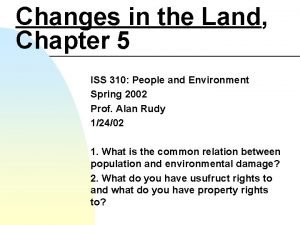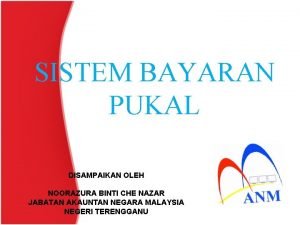Changes in the Land Chapter 5 ISS 310









- Slides: 9

Changes in the Land, Chapter 5 ISS 310: People and Environment Spring 2002 Prof. Alan Rudy 1/24/02 1. What is the common relation between population and environmental damage? 2. What do you have usufruct rights to and what do you have property rights to?

Commodities of the Hunt: n n n Trade Diseases Property Ecological Change Hunting Commodification u Exchange F Use/Status -- Wampumeag F Accumulation/Abstraction -- Price n Sedentarism

Early Trade and Diseases: n n Indians eager by 1525 -- 33 years after ? ? Diseases u Historical-Geographic isolation u Low population densities u No domesticated animals u Neither genetic, nor acquired resistance n 80 -90% Mortality Rates u Endemic and Acute u Hunter-gatherer North less than Ag South n Smallpox, TB, Influenza, Pneumonia, Measles, Typhus, Dysentery, Syphilis

Consequences of Diseases: n n Powerfully disrupts kinship patterns, interand intra-group politics, healing/religion. Facilitates colonial property take-over u if Indians had “improved” and thereby “owned” ag lands, but died, then those lands could be taken u indication of “God’s will” behind Colonist take-over n Second nature reverts to first nature? u SMALL GROUPS -- explain (90 -91)

Hunting: n n n Colonists were too ineffective a hunters to obtain furs by themselves, needed Indian men. But Indian men were lazy and had inferior technology! How could Indians be more efficient and skillful?

SEE Cronon’s ARGUMENT? ? ? n Cronon is BUILDING an argument with the structure of the book, u ECOLOGY F Northern u SOCIAL and Southern NE ECOLOGIES F Indians (N and S) and Colonists ( English) u POLITICAL ECOLOGY F Sovereignty u ECONOMIC ECOLOGY F Population, n n and Property Hunting, Trade Each point adds a layer and refers back Why THAT order? N-S-P-E?

Commodification: n For Indians, from exchange of equivalents (use) to accumulation of abstractions (price). u 1) Use Euro-goods for Indian purposes u 2) Trade for Indian purposes n n Indian-Colonist trade grew not due to Indian demand but because of Colonists’ need to pay debts (not supply-demand). Trade + Disease worked against old political and status hierarchies. u Declining population worked against social sanctions against accumulation.

Summary (of sorts): n Trade + Pop = Deregulation (Indians) u Eco Damage (for Colonists) u Eco populations F Fur ( Indian need for cloth) F Rich land from beaver dams F Game u Sedentarism F Indians • Domesticated animals – Disease F Colonists n Normal Env’tal Accounts u Pop = Eco Damage

Conclusion: u Nature (ecology) + u Social Relations (gender, culture, etc. ) + u Political Organization (status, state, etc. ) + u Economic Structure (tech. , class, etc. ) + u Population (numbers, trends) + u Health (diseases, lifespan, etc. ) = n n All must be understood in changing relation to one another in order to coherently explore environmental change and respond to crises. None alone will do (not holism, philosophy, democracy, biotech, consumption, birth control, or medicine) alone.

















